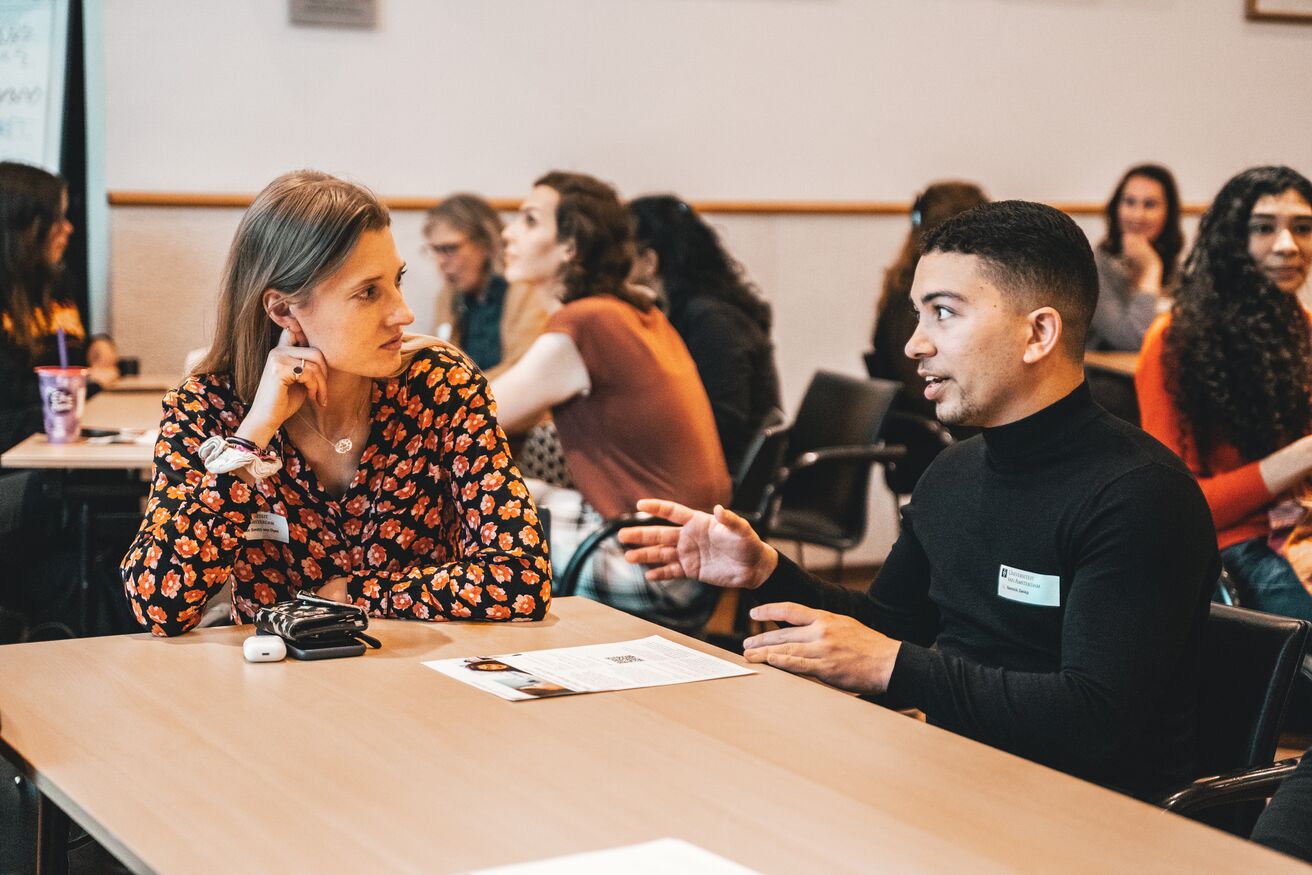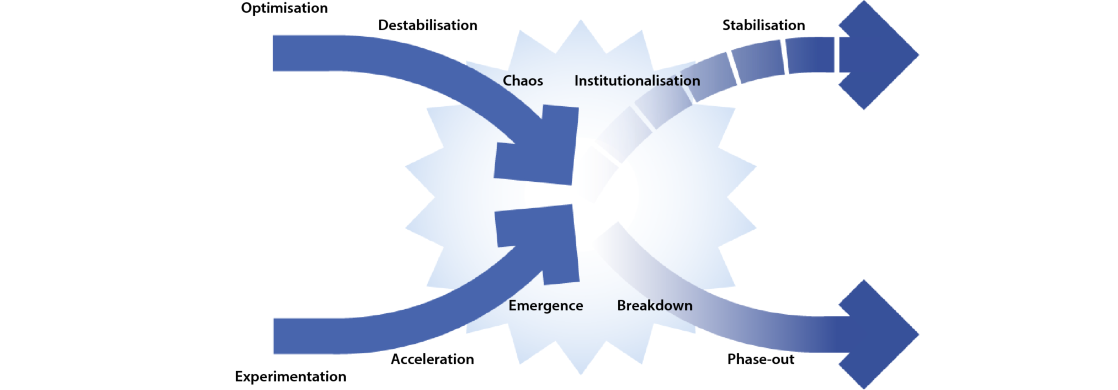
Kick-off Higher Education in Transition (HOT)
Kick-off of HOT: Playroom for education
Recently the Institute for Advanced Study (IAS) hosted the kick-off of HOT, Higher Education in Transition. A new initiative by several university teachers, education directors and education experts, in search of innovation and creation in education and research. Coming from the Institute for Interdisciplinary Studies (IIS) and the Faculty of Social and Behavioural Sciences (FMG). But also, from the central
team of the network of UvA Teaching & Learning Centres (TLC Central) and IAS. They had invited colleagues from the Dutch higher education field for this first meeting to spar about the future of education, research and the interaction between the two. It turned out to be an interactive, creative afternoon where the boundaries of what might be possible were explored and pushed. This afternoon’s theme: Playroom for education.
HOT initiators (left to right): Huub Dijstelbloem (IAS), Mariska Min (TLC Central), Ingmar Visser (FMG), Lucy Wenting (IIS), Mieke Lopes Cardozo (FMG), Luca Bertolini (IIS) en Linda de Greef (IIS).
About HOT: looking for innovation and creation and more movement in it
HOT is looking for innovation and creation in education and research and wants to allow more movement in this. The initiative wants to push the boundaries in higher education and enable ‘benign disruptions’.
To brainstorm about this with peers from higher education, HOT organizes a number of meetings, with different and also recurring parties. The theme for this first meeting either kick-off was ‘Playroom for education‘. Read more about this meeting below.
More info and/or ideas?
HOT will organise several ‘omdenk sessions’ in the future and will also involve students.
Would you like more info on the initiatives from HOT? Or would you like to participate in these and/or have ideas? Then get involved!
Motivated participants and their mainspring for innovation and creation
The opening question to participants and initiators was ‘Why do you want to participate in this initiative’? Some of the motivational drivers mentioned:
“Research is for knowledge generation and education for knowledge transfer – we need to challenge this. After all, it can also be the other way around. Where is the division?”
“Education should be given a more important place within the university: teaching is the underdog versus research. This is reflected in the designations: research time and teaching load.”
“The creativity and innovativeness of researchers evaporate in education, partly due to the massiveness and standardization of teaching. We want to reverse this trend.”
“In addition, it is not clear where education is headed. How can education regain creativity and clear direction?”
More connected and prepared
Looking for an answer, participants indicated that universities should be more connected to society and societal challenges. Another issue that emerged was how to better prepare students for a future we do not know. Education is mostly not for what happens tomorrow. A transition like the rise of AI programs such as ChatGPT was cited as an example. We are more or less caught off guard by such transitions now, but how do we ensure that we are prepared for them, can spot learning opportunities in time and are better able to move with them?
What if everything was possible?
The aim of the kick-off was: to collect limitless dreams and wishes for higher education. This was done by defining what if questions: ‘What if everything were possible? What would higher education look like?’
First, a short attention exercise was done to get into an out-of-the-box mindset. Then people split into small groups to come up with what if questions to further philosophize and build on. The out of the box outcomes were fed back to the group after about 20 minutes. Some what if questions were:
- ‘What if there were no diplomas/tests/exams?’
- ‘What if we learned like an ecosystem: adaptive, physical, playful, resourceful?’
- ‘What if we did the same with seven generations back and forward in mind?’
- ‘What if there were no more boundaries between learning, play and work?’
- ‘What if education was a joint expedition of teachers and students with unknown destinations?
X-Curve
The what if questions were then applied to the X-curve for each group. The X-curve was developed by DRIFT, a research institute at Erasmus University within the field of sustainability transitions.
They argue that transitions are processes of both construction and breakdown. You can plot the underlying dynamics in the so-called X-curve. The arrow from bottom left to top right is about building up the new and the arrow from top left to bottom right is about demolishing the old. What is the practice and what will we stop doing? What do we want to experiment with and what do we ultimately want to perpetuate?

Without diplomas, tests and exams
From the what if question “What if there were no diplomas/tests/exams?” came, for example, the experiment of letting students set learning objectives. And letting them decide for themselves how they show that they have met the learning objectives. What the group wanted to perpetuate through this emphasis on student autonomy and self-direction was continued enjoyment of learning and the phasing out of the performance culture.
Boundaries between learning, playing and working
The team that played with the boundaries between learning, playing and working wanted to step beyond the boundaries of disciplines and work more extracurricularly. The aim here: to let learning become more play and discovery and less interest in institutionalized education. For example, you can also learn outside the university. Students can learn from problems in society and find creative solutions to them. In this way, you gain work experience ‘while playing’.
Education as a joint expedition
The group that saw education as a joint expedition with unknown destinations emphasized co-creation of learning pathways and making deeper connections. Learning objectives are co-determined by students. No grades are given, but reflection afterwards, for example. Regularly looking back and forward gives quality to the expedition. The desire for a deep democracy-like society and education emerged in several elaborations of what if questions.
Reflection on the afternoon
It was a successful afternoon with plenty of room for out-of-the-box ideas. The HOT organizers and participants also noted a huge unanimity towards ‘constructive disruption’ and the importance of organizing counterforce. Many commonalities emerged from the various discussions, seen in the elaboration of the X-Curves on posters.
Creating ‘HOT spots’
An initial idea that emerged from this meeting was to create several ‘HOT spots’: locations for educational experiments at different institutions. From these, a HOT community of innovators could start. To learn from each other, disseminate ideas, make them concrete, research and realize them. Perhaps HOT could develop a number of courses to experiment with the concept of ‘learning together’ as a starting point.
Importance of HOT community
All participants expressed a desire to be part of this HOT community. “It is nice to connect with each other, we have different backgrounds but the same struggles and need for radical innovation. It is of added value to think together in terms of possibilities.”






